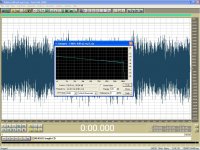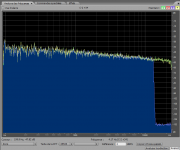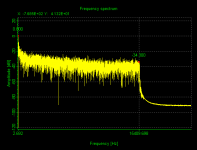Aren't we forgetting non-linearity of the ear itself ? It's easy to overlook the fact that the mechanical part of the ear is quite non-linear at the best of times especially at high SPL, and it certainly doesn't take much (a tiny bit of wax resting against the eardrum for example) to make it MUCH more non-linear to the point where non-linear distortion at moderately high SPL becomes plainly obvious. (As someone who suffers from excess ear wax production, I can attest to the latter...)Once again, the notion of beats from supersonic tones is a canard. You would have a hard time proving that it existed in music to any real degree. If it did then the audible difference tones would have already been generated and would be recorded and reproduced by an accurate system (so no need to record the inaudible supersonic components). If your system is converting supersonic tones into audible beats, then that indicates huge distortion.
If there is strong supersonic content at the original event, these would potentially inter-modulate in the ear and be perceived as difference tones in the audible spectrum to which the hair cells can respond...
Capturing a band limited recording and reproducing it on band limited speakers would prevent this happening - potentially the recorded signal might sound "cleaner" than the original event because of it. (Better than the real thing ?)
However, I don't really think this is a good reason why we should try to record and reproduce high SPL supersonic sounds - yes, it might potentially sound closer to reality, but all you'd be doing is more accurately stimulating the distortions introduced by the ear - distortions that are most probably undesirable and different from person to person anyway.
I guess it would come down to do we want it to sound the closest to reality (warts and all, including the full range of undesirable distortions introduced by the ear at the live performance) or do we want it to sound the best possible within the actual bandwidth of the ear ?
Personally I don't want to hear more of my ears inherent distortions, even if it might technically be more realistic. Others might have a different opinion.
What bit-rate are they ? (Sorry, haven't had time to test them yet) If they're at least 256kbit you're probably ok. Less than this and they won't be suitable for testing 16 or 20Khz as they will be brick-wall low pass filtered. (Did you do a spectral analysis of the decoded MP3 file to see how closely it matched the source WAV file at the top end ?)MP3 files aren't worthy of showing the effect of a response error? Then I guess you won't hear anything if you try them.
Last edited:
You sure its not the non-linearity of the ear that's being exploited ? Air is far, far more linear than the ear at any given SPL, and it would take truly tremendous SPL for the linearity of the air to be bad enough to inter-modulate two supersonic tones to become audible. (And then how would you control what part of the air is doing the inter-modulating for you, if your beam had more or less expanded into a plane wave by the time it reached the listener)That's the guys down in San Diego. You can see their devices in use by the Navy and the Japanese whaling ships. Non-linearity of the air is exploited.
It's not just the navy that have access to such technology - you can buy commercially available panel arrays of modest size (less than a metre across) that will project a sound on just one person at distances of 10 metres or so, I remember seeing one demonstrated on the Gadget Show (UK tv show) last year. As far as I know on these the inter-modulation is occurring in the ear of the person its aimed at, not the air.
Last edited:
(Did you do a spectral analysis of the decoded MP3 file to see how closely it matched the source WAV file at the top end ?)
Hello David
Simon has a point. If you watch the file in the analysis window you can see the upper octave being modulated by the filter action but there in no real content in the last octave above 15K. That explains why I could hear a difference at 20K.
Rob🙂
Attachments
Last edited:
Well spotted, assuming its the MP3 encoding process that has added the brick-wall filter at 15Khz, (probable, but only Dave can confirm this for us by opening the original wav files to compare them) this is a good example of why MP3 can often be audibly different to original source material - I for one can hear the effects of a brick wall filter applied at 15Khz 😉If you watch the file in the analysis window you can see the upper octave being modulated by the filter action but there in no real content in the last octave above 15K.
From what I can remember AAC handles the top octave very differently from MP3 at similar bit-rates and does a much better job. (I also prefer the sound of AAC over MP3 at equal bit-rates)
The frequency of the brick-wall low pass filter in MP3 encoding depends on the encoder itself, the encoding options, and the bit-rate chosen. I think it is possible to disable it (or shift it out to very close to the nyquist frequency, eg nearly 22Khz) with the right encoder and encoding options to make a pink noise treble test like this valid.
Certainly when generating MP3 test files the resulting encoded file needs to be verified to make sure the encoding process hasn't cut off the very frequencies we're trying to compare. 🙂
Last edited:
I have used Cool edit for many years, and I was generally under the impression that, the higher sample rates/clocking freqs actually allowed a much higher AA filter than 15k.....im rather surprised by what others have said in a similar vein. I usually record in .wav, and convert at the highest bitrate to MP3, but only if i have to! recording at 96khz, as most soundcards do, or are capable of there is no issue with AA filter, but for a test using parametric eq on pink noise, what reason would you convert to mp3? the files would be tiny even as wav....
The brick wall low pass filter employed in MP3 encoding is nothing to do with anti-aliasing, anti-aliasing has already been dealt with by the time the uncompressed PCM audio stream is sent to the MP3 encoder for encoding.I have used Cool edit for many years, and I was generally under the impression that, the higher sample rates/clocking freqs actually allowed a much higher AA filter than 15k.....im rather surprised by what others have said in a similar vein.
It's purely there to eliminate "unnecessary" high frequency content which would otherwise consume a large amount of the available bit-rate budget when encoding, as I described earlier in the thread. Given a limited bit-rate its an optimisation that improves overall quality by assigning bits where they make the most difference to quality. (The assumption being that a loss of very high frequencies is less noticeable than poor encoding of mid frequencies etc)
With a high enough bit-rate this "optimisation" can be dispensed with and the full bandwidth up to the nyquist frequency encoded.
Last edited:
I'll have to investigate the encoding options. I confess I just hit "save as" and didn't look at the variables. I'm pretty sure I listened to the MP3 files (as well as the originals) and heard significant differences. I didn't save the uncompressed files but they aren't too hard to recreate.
David
David
Oh and until we are still OT, let me add that MPEG1 layer3 standard is extremely inefficient with high frequencies due the bug/error in the standard. It is missing a scalefactor to add more resolution to the high freq. band, so it has to increase resolution globally, across all bands. Very inefficient. Thats why it is 'easier' to brickwall anything above 15kHz. AAC is better not only because it is missing this 'feature', but largely due superior transient handling because of smaller block size. No way to code transparently something like Autechre/castanets etc.
Yes, sure. As I tried, and failed, to get a patent on some assimilate techniques, I have a pretty good idea what they are doing. The SPLs are very high, thus the air comes into play. It's not the whole technique, just part of it.You sure its not the non-linearity of the ear that's being exploited ?
Sorry, we are drifting OT.
A precision about mp3 encoding. On a pink noise 48000/32 bits floating, encoded in Adobe Audition with it's codec in mp3 48000 Hz. FFT of the diagram max size.
On the diagram are compared the original PCM, a mp3 CBR max bitrate (128 kps in mono) and a mp3 CBR intermediate bitrate (64 kps in mono ).
The two top lines are the PCM and the 128 kps, there is no evident (visual) difference. The zone is the 128 kps where the brick wall low pass appears.
On the diagram are compared the original PCM, a mp3 CBR max bitrate (128 kps in mono) and a mp3 CBR intermediate bitrate (64 kps in mono ).
The two top lines are the PCM and the 128 kps, there is no evident (visual) difference. The zone is the 128 kps where the brick wall low pass appears.
Attachments
Hey David, thanks for the files. Alas, since you saved them as 64 kbs mp3s, they have a brick wall filter at 15.5KHz. You can see this in the FFT below. Similar to Gazon's graphs above. For what you want to test, that's too low.Here are some samples of pink noise with a response error added.
From my tests just about all MP3 rate brick-wall, the highest at 19Khz. That may be a setting in LAME, the encoder. However, I did find that if you export as Ogg Vorbis at 120 kbs (mono) full bandwidth is retained and the files are small. If you can export that way, give it a try.
Attachments
Looks like you're right, here's a chart of different low pass frequencies versus quality settings for Lame:From my tests just about all MP3 rate brick-wall, the highest at 19Khz. That may be a setting in LAME, the encoder.
LAME - Hydrogenaudio Knowledgebase
I thought there was a way to manually override it but perhaps not.
Did you also try AAC ? Both Ogg Vorbis and AAC are clearly better than MP3 for the same bit-rate (it's no contest) but its a lot less clear which one of those two is better, or more suitable for a test like this.However, I did find that if you export as Ogg Vorbis at 120 kbs (mono) full bandwidth is retained and the files are small. If you can export that way, give it a try.
Can we not just use zipped wav files to avoid the whole issue, or will the resulting file size be too big for a forum attachment ?
FlacCan we not just use zipped wav files to avoid the whole issue, or will the resulting file size be too big for a forum attachment ?
Nah, I never touch the stuff! 😀 Don't know if I have that format here, will look.Did you also try AAC ?
10 secs of noise as a mono FLAC would be about 650kb, so that would work. As a Q7 Ogg, about 133kb
Someone (the military?) was developing a highly directional sound source that used very high frequency upscaled audio with two carriers that would beat and intermod down to an audible frequency. I can't remember if they were using nonlinearity in the air or in our hearing.
p.s. I assume Earl was referring to the 1 Hz (or 40Hz) difference frequency rather than 440.
The technique was first used for sonar, under water. It uses the nonlinearity of the waves propagation to create this effect. (And no air is not nonlinear enough at audible levels to create this effect between a 17,000 Hz tone and a 17,440 hz tone, which does have a "beat" frequency of 440 Hz.)
The audible devices use very high intensity sound modulated about 50 kHz to create LF difference tones. But this is done in the very near field of the transducer where the nonlinearity will be significant enough to create an audible difference frequency. Trouble is that it does take a lot of power to do this and it has no LF efficiency at all.
I'm running out of steam at around 16kHz and I'm not sure a second round would show me anything new. Unless that earlier comment about 'sensing' ultrasonics has merit.Hey David, thanks for the files. Alas, since you saved them as 64 kbs mp3s, they have a brick wall filter at 15.5KHz.
By the way that last one was subtle but once I focussed on it I found it distinct and objectionable. Could I get a reality check that I hadn't talked myself into that?
- Status
- Not open for further replies.
- Home
- Loudspeakers
- Multi-Way
- What are benefits of adding HF driver 7khz up?



